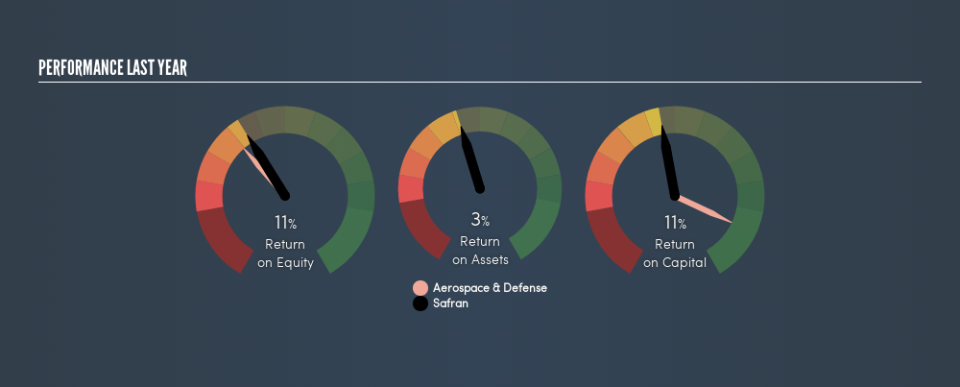Why You Should Like Safran SA’s (EPA:SAF) ROCE

Today we'll evaluate Safran SA (EPA:SAF) to determine whether it could have potential as an investment idea. To be precise, we'll consider its Return On Capital Employed (ROCE), as that will inform our view of the quality of the business.
First, we'll go over how we calculate ROCE. Then we'll compare its ROCE to similar companies. Then we'll determine how its current liabilities are affecting its ROCE.
What is Return On Capital Employed (ROCE)?
ROCE measures the 'return' (pre-tax profit) a company generates from capital employed in its business. In general, businesses with a higher ROCE are usually better quality. Ultimately, it is a useful but imperfect metric. Author Edwin Whiting says to be careful when comparing the ROCE of different businesses, since 'No two businesses are exactly alike.'
How Do You Calculate Return On Capital Employed?
Analysts use this formula to calculate return on capital employed:
Return on Capital Employed = Earnings Before Interest and Tax (EBIT) ÷ (Total Assets - Current Liabilities)
Or for Safran:
0.11 = €2.1b ÷ (€41b - €21b) (Based on the trailing twelve months to December 2018.)
So, Safran has an ROCE of 11%.
See our latest analysis for Safran
Does Safran Have A Good ROCE?
ROCE is commonly used for comparing the performance of similar businesses. Using our data, we find that Safran's ROCE is meaningfully better than the 8.1% average in the Aerospace & Defense industry. I think that's good to see, since it implies the company is better than other companies at making the most of its capital. Separate from Safran's performance relative to its industry, its ROCE in absolute terms looks satisfactory, and it may be worth researching in more depth.
Safran's current ROCE of 11% is lower than its ROCE in the past, which was 26%, 3 years ago. So investors might consider if it has had issues recently. You can click on the image below to see (in greater detail) how Safran's past growth compares to other companies.
Remember that this metric is backwards looking - it shows what has happened in the past, and does not accurately predict the future. Companies in cyclical industries can be difficult to understand using ROCE, as returns typically look high during boom times, and low during busts. ROCE is only a point-in-time measure. Since the future is so important for investors, you should check out our free report on analyst forecasts for Safran.
Safran's Current Liabilities And Their Impact On Its ROCE
Current liabilities are short term bills and invoices that need to be paid in 12 months or less. The ROCE equation subtracts current liabilities from capital employed, so a company with a lot of current liabilities appears to have less capital employed, and a higher ROCE than otherwise. To counter this, investors can check if a company has high current liabilities relative to total assets.
Safran has total assets of €41b and current liabilities of €21b. As a result, its current liabilities are equal to approximately 52% of its total assets. Safran has a relatively high level of current liabilities, boosting its ROCE meaningfully.
Our Take On Safran's ROCE
The ROCE would not look as appealing if the company had fewer current liabilities. Safran shapes up well under this analysis, but it is far from the only business delivering excellent numbers . You might also want to check this free collection of companies delivering excellent earnings growth.
I will like Safran better if I see some big insider buys. While we wait, check out this free list of growing companies with considerable, recent, insider buying.
We aim to bring you long-term focused research analysis driven by fundamental data. Note that our analysis may not factor in the latest price-sensitive company announcements or qualitative material.
If you spot an error that warrants correction, please contact the editor at editorial-team@simplywallst.com. This article by Simply Wall St is general in nature. It does not constitute a recommendation to buy or sell any stock, and does not take account of your objectives, or your financial situation. Simply Wall St has no position in the stocks mentioned. Thank you for reading.

 Yahoo Finance
Yahoo Finance 